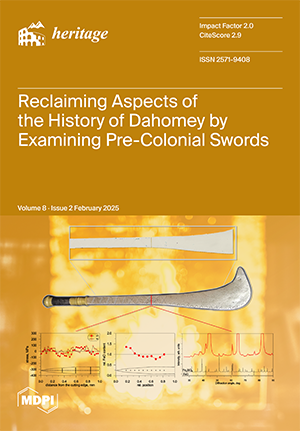Key Points
Non-invasive nuclear techniques have helped to reveal the composition and manufacturing history of historic African swords associated with Dahomey's unique female fighting force
The swords may likely have been made from locally smelted iron
The research sheds new light on African craftsmanship and technological sophistication
ANSTO scientists from the Australian Centre for Neutron Scattering were members of an inter-disciplinary team led by the University of Sydney, who examined six 19th century West African swords, using a non-invasive multi-methodological approach to reveal the composition and manufacturing history of the iron implements.
These striking heritage objects made in the West African kingdom of Dahomey (now part of the Republic of Benin), may likely have been made from locally smelted iron, which is something that contradicts the assumptions of the few existing historical reports.

The research, published in Heritage, and featured on the cover, highlights ANSTO's expertise in the examination of cultural heritage materials.
The swords are associated with Dahomey's unique female fighting force, continuing today in contemporary women soldiers and palace guards.
Insights based on neutron tomography done on the Dingo instrument, powder diffraction done on the Wombat instrument and diffraction residual stress measurements done on the Kowari instrument confirmed the swords were made by African smiths and not imported from Europe.
Neutron tomography suggested forging for all six swords. The tomographic reconstructed cross sections revealed differences in the porosity of the metals used in the swords.
The geometry, size, orientation, location and type of connectivity of the pores are directly related to the metal's forging and welding processes.
Three of the six swords, although similar in stylistic features, show some differences in internal structure.
"Importantly, the combination of neutron tomography images and neutron diffraction analyses provide a wealth of new insights into the manufacture of African swords. In particular, it sheds new light on African craftsmanship and technological sophistication," explained Dr Floriana Salvemini, an expert in historical metallurgy.
Neutron diffraction residual stress analysis conducted on five of the Dahomean blades showed considerable variation in the way the blades were manufactured. It appeared that the blades were produced following different practices, manufacturing steps and treatments resulting in distinct stress distributions in the metals.
Neutron diffraction data analysis showed quantitatively a clear difference between the swords and three distinct groups can be isolated based on the phase composition, also suggesting different practices of the metalworking.
Although the analysis did not clearly validate provenance of the metal in Dahomey, the composition suggests that possible sources of iron were Bassar (now Togo) or Sweden or the Ruhr Valley or even Brazil (via slaves).
Archaeologists who contributed to the research reported that the swords were ritual objects, possibly linked to magico-religious rites and observances and local iron may have been preferred for these purposes.
The evidence suggests that all were masterfully created by local smiths, half of them using a distinctive forging technique that appears to be Dahomean.
ANSTO scientists who also contributed to the research included Dr Vladimir Luzin and Prof Max Avdeev.
The swords were made available to research partners from an old private collection in France.






